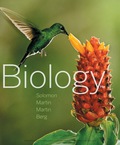
EBK BIOLOGY
11th Edition
ISBN: 8220106820636
Author: Martin
Publisher: CENGAGE L
expand_more
expand_more
format_list_bulleted
Concept explainers
Textbook Question
Chapter 31.3, Problem 11LO
Describe six key characteristics of arthropods, summarize proposed phylogeny of arthropods, and distinguish among arthropod clades; give examples of animals that belong to each group.
Expert Solution & Answer
Want to see the full answer?
Check out a sample textbook solution
Students have asked these similar questions
How do histamine and prostaglandins help in the mobilization of leukocytes to an injury site? What are chemotactic factors? How do they affect inflammation process?
Compare and contrast neutrophils and macrophages. Describe two ways they are different and two ways they are similar.
Describe the effects of three cytokines (not involved in the initial inflammation response). What cells release them?
Chapter 31 Solutions
EBK BIOLOGY
Ch. 31.1 - Prob. 1LOCh. 31.1 - Prob. 2LOCh. 31.1 - Prob. 3LOCh. 31.1 - connect What is the significance of choanocytes in...Ch. 31.1 - Prob. 2CCh. 31.1 - VISUALIZE Sketch the major events of the life...Ch. 31.1 - Prob. 4CCh. 31.2 - Prob. 4LOCh. 31.2 - Prob. 5LOCh. 31.2 - Prob. 6LO
Ch. 31.2 - Prob. 7LOCh. 31.2 - Prob. 8LOCh. 31.2 - What are some advantages of cephalization and a...Ch. 31.2 - On what basis have biologists classified...Ch. 31.2 - Prob. 3CCh. 31.2 - Prob. 4CCh. 31.3 - Prob. 9LOCh. 31.3 - Prob. 10LOCh. 31.3 - Describe six key characteristics of arthropods,...Ch. 31.3 - Prob. 12LOCh. 31.3 - Prob. 1CCh. 31.3 - Describe four key arthropod characteristics, and...Ch. 31.3 - Prob. 3CCh. 31.3 - Describe four adaptations that have contributed to...Ch. 31 - Prob. 1TYUCh. 31 - Prob. 2TYUCh. 31 - Which of the following is associated with the...Ch. 31 - Trochophore larvae are characteristic of (a)...Ch. 31 - Prob. 5TYUCh. 31 - An open circulatory system (a) is characteristic...Ch. 31 - Which of the following characteristics is...Ch. 31 - Trilobites (a) were early mollusks (b) are...Ch. 31 - Prob. 9TYUCh. 31 - Prob. 10TYUCh. 31 - The correct sequence of complete metamorphosis of...Ch. 31 - Test Your Understanding 12. VISUALIZE Draw a cross...Ch. 31 - Prob. 13TYUCh. 31 - Prob. 14TYUCh. 31 - INTERPRET DATA Imagine that you discover a new...Ch. 31 - Prob. 16TYUCh. 31 - Prob. 17TYUCh. 31 - Prob. 18TYUCh. 31 - SCIENCE, TECHNOLOGY, AND SOCIETY international...
Knowledge Booster
Learn more about
Need a deep-dive on the concept behind this application? Look no further. Learn more about this topic, biology and related others by exploring similar questions and additional content below.Similar questions
- Describe how the inflammation response starts including the sentinel cells and the chemicals involved. How do pathogens trigger the response particularly in the skin?arrow_forwardHow does complement promote the immune response? Describe three waysarrow_forwardWhich of the following is not a possible mechanism for autoimmunity? Select one: A. Abnormal expression of MHC II molecules in non-antigen-presenting cells B. Activation of polyclonal B cells C. Polymorphism of HLA alleles D. Molecular mimicry E. Release of sequestered antigensarrow_forward
- WRITTEN WORK 3: NON-MENDELIAN GENETICS Part A: Complete the Punnett square and calculate for the probability of genotype and phenotype. i i Genotype: Phenotype: 08:55arrow_forward1:42 PM ១ 99% Apart from food, plants need other nutrients like water and minerals. Nitrogen, a mineral, is an important part of all living cells. All organisms need nitrogen in order to grow and repair. Although nitrogen exists in its elemental form in the atmosphere, it cannot be directly used by plants. 7 Where else can plants obtain their nitrogen from? Plants make their own nitrogen. B Plants get it from animals. Plants get it from the soil. D Plants have special structures to break down atmospheric nitrogen. v3.7.63.140.4 | 6763e9417a3dbb80fa0f87b2 | Dec 19, 2024 | 3:07 PM | 84126 | en_8arrow_forwardCompare the cloning efficiencies: SmaI vs. EcoRI.arrow_forward
- Hydrogen bonds play an important role in stabilizing and organizing biological macromolecules. Consider the four macromolecules discussed. Describe three examples where hydrogen bond formation affects the form or function of the macromolecule.arrow_forwardImagine you are a botanist. Below are characteristics of a never-before described plant species recently identified as part of the ‘All Taxa Biodiversity Inventory’ (ATBI). Field Notes: Specimen collected from shaded area along stream in South Cumberland State Park (Grundy County, TN). Laboratory Analysis: Body: Large leaves emerging from underground rhizome. Size: 63 cm Chromosomal Analysis: Plant body is diploid—chromosome number of 44. Lignin test: Positive Cuticle: Present Leaves: Present—large with branched veins. Underside has sori (containing haploid spores). Roots: Present—branch from the inside. Stem: Present—vascular tissue (xylem & phloem) present. Life History: Diploid sporophyte dominant generation. Haploid spores germinate into heart-shaped, haploid, gametophyte. Water required for fertilization; no seed is produced. Diploid zygote develops into sporophyte. Explain which domain, kingdom and phylum you believe this plant should be classified…arrow_forwardCUÁ Glycine A C C Newly formed molecule Glycine Arginine Proline Alanine A C C CC G GGAUUGGUGGGGC Structure X I mRNAarrow_forward
arrow_back_ios
SEE MORE QUESTIONS
arrow_forward_ios
Recommended textbooks for you
 Concepts of BiologyBiologyISBN:9781938168116Author:Samantha Fowler, Rebecca Roush, James WisePublisher:OpenStax College
Concepts of BiologyBiologyISBN:9781938168116Author:Samantha Fowler, Rebecca Roush, James WisePublisher:OpenStax College

Concepts of Biology
Biology
ISBN:9781938168116
Author:Samantha Fowler, Rebecca Roush, James Wise
Publisher:OpenStax College
From Sea to Changing Sea | Early Life in the Oceans || Radcliffe Institute; Author: Harvard University;https://www.youtube.com/watch?v=Ac0TmDf5Feo;License: Standard youtube license